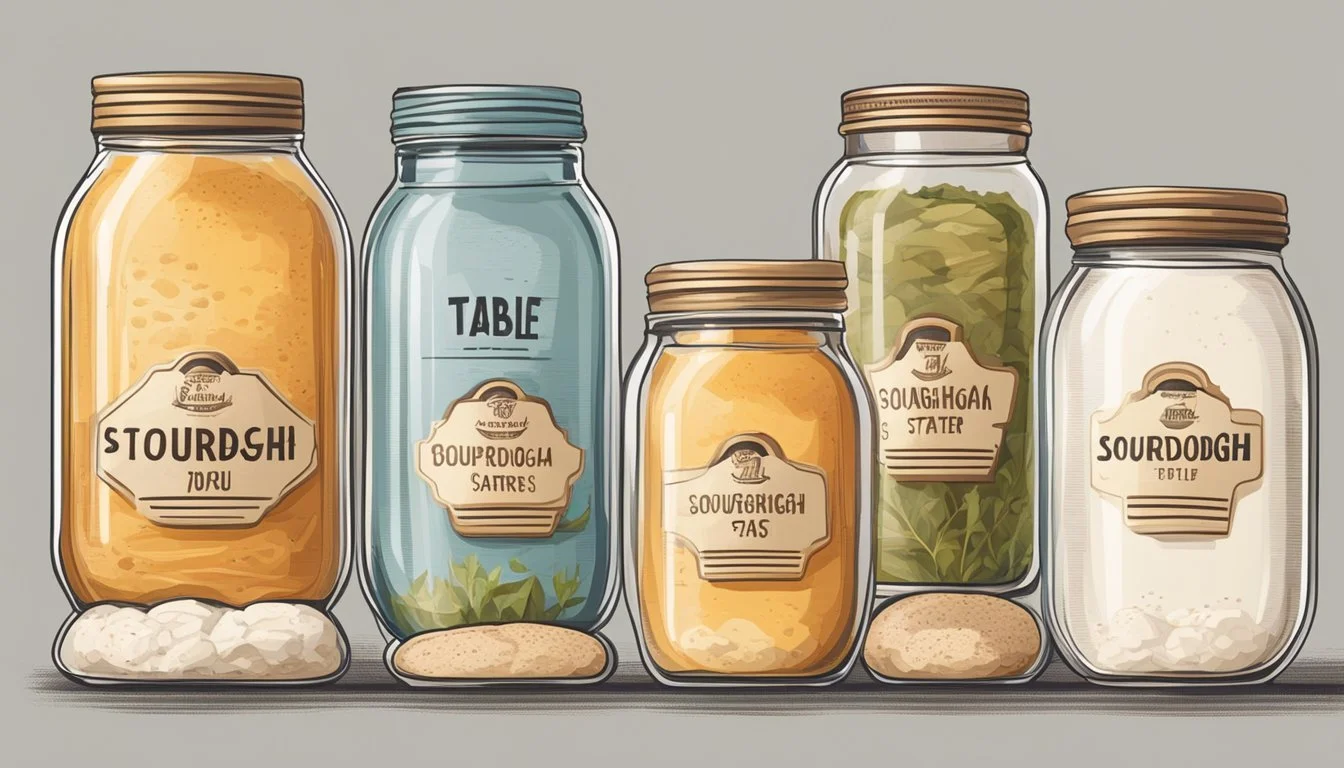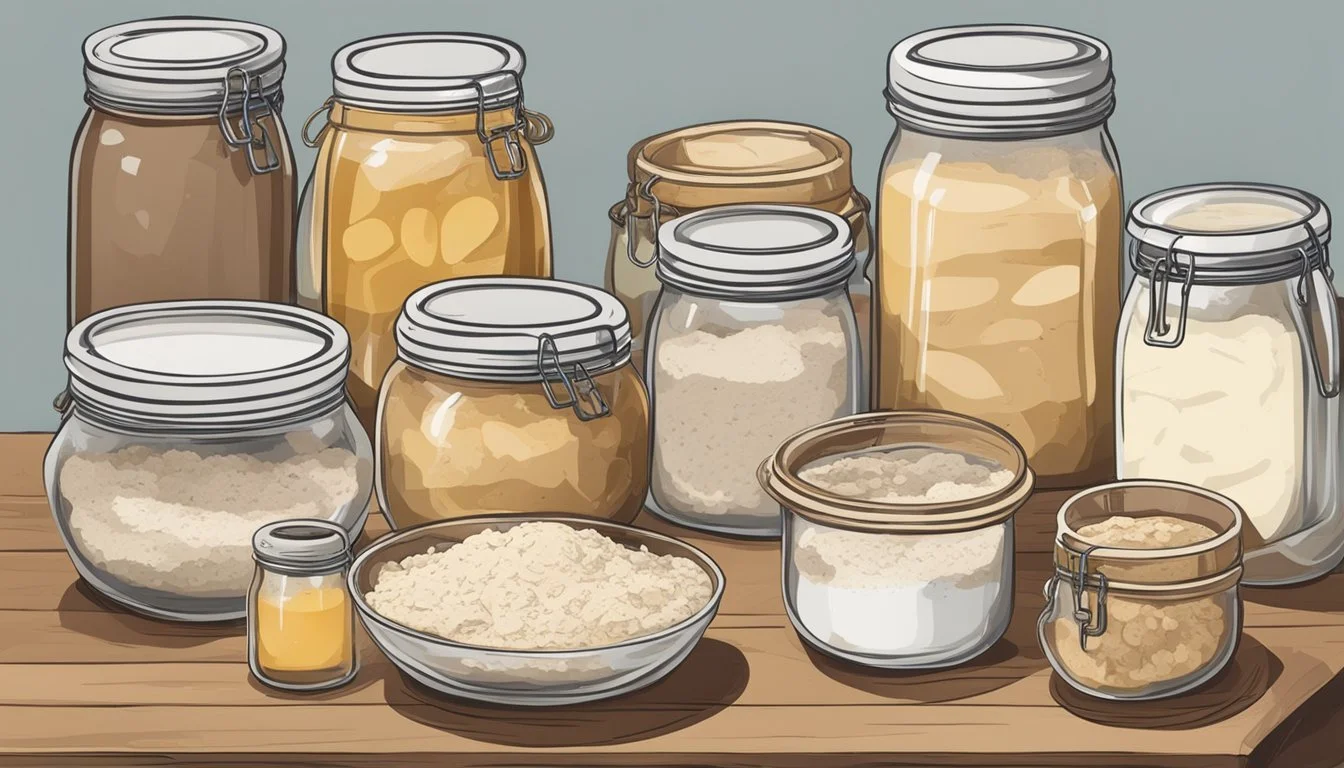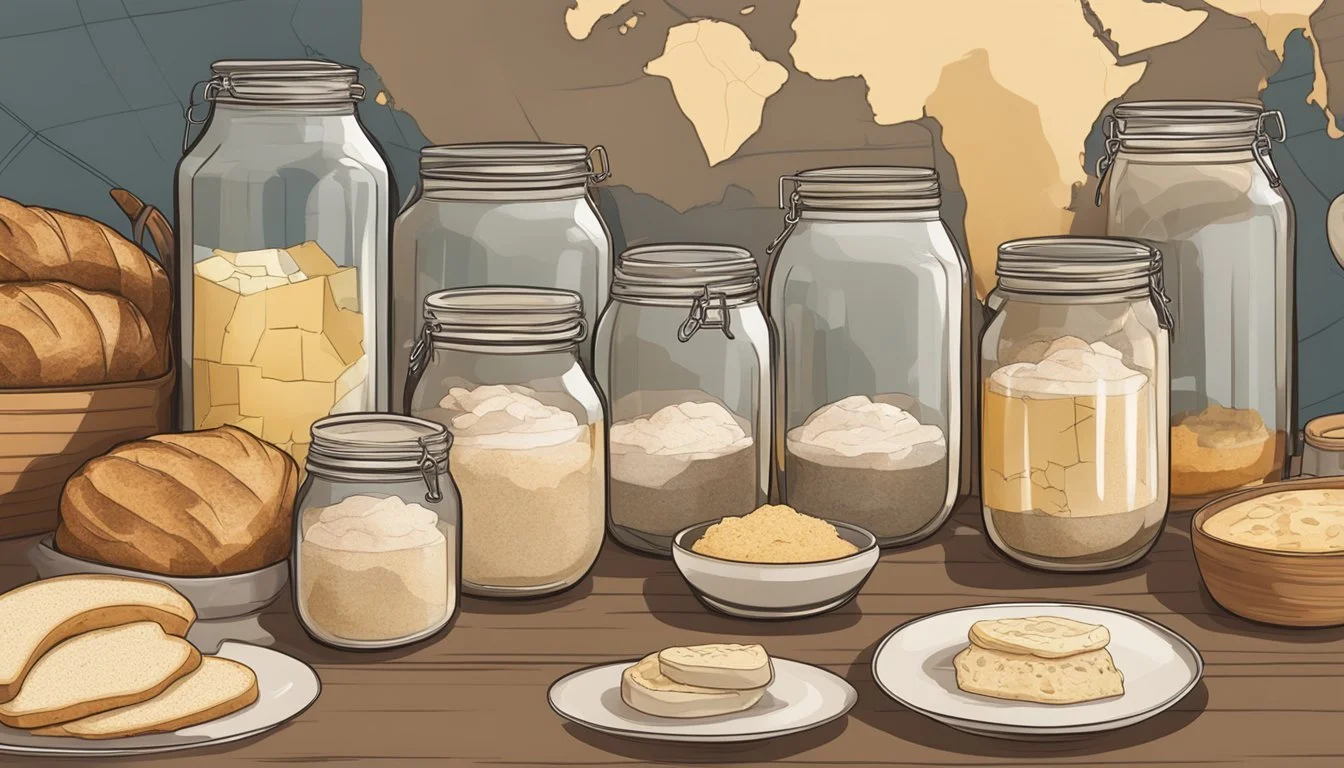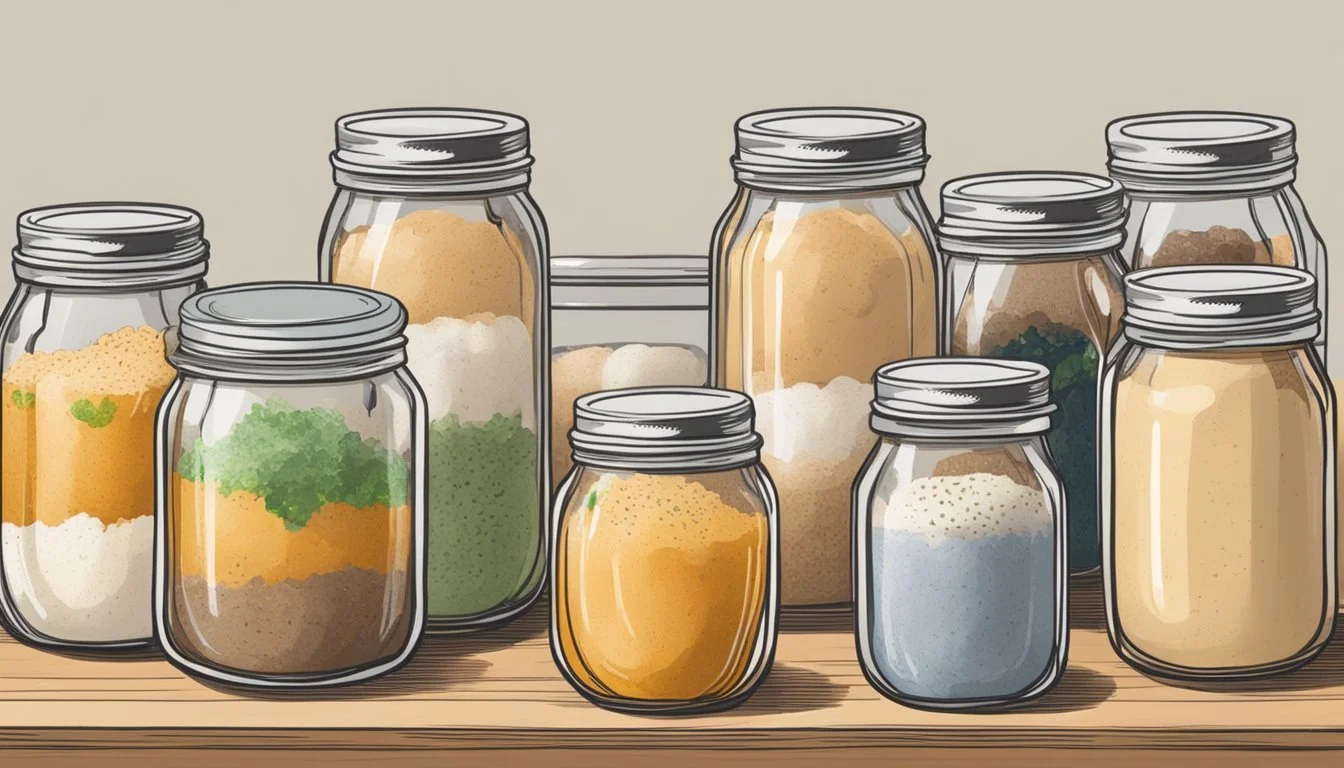Sourdough Starters from Around the World
A Global Guide to Traditional Cultures
Sourdough starters, the cornerstone of traditional bread (What wine goes well with bread?) baking, have experienced a resurgence in popularity in recent years, capturing the attention of both artisan bakers and home enthusiasts alike. The culture of sourdough is as diverse as it is widespread, with each region of the world fostering its own unique strains of wild yeast and lactic acid bacteria. These microorganisms, which are responsible for the fermentation process, impart distinct local flavors and characteristics to the bread they produce.
A sourdough starter is not simply a mixture but a living culture that reflects its environment. As such, starters from different parts of the world vary greatly in taste and behavior. For example, a San Francisco sourdough is renowned for its tangy flavor, attributed to the specific lactic acid bacteria present in the region, while a starter from France might offer a more subtle sourness, well-suited to the rustic breads of the area.
This variation in sourdough starters not only highlights the cultural heritage embedded in bread-making traditions but also the natural diversity of yeast and bacteria that leaven bread. The art of maintaining and baking with sourdough starters is a testament to the age-old practice of fermentation, an essential process that not only raises the dough but also enhances the nutritional profile of the bread, making it more digestible and flavorful.
History and Origins
Sourdough bread has a rich narrative woven throughout human history, with a documented timeline that traces back to ancient civilizations and spans to contemporary kitchens across the globe. This journey showcases the diversity and resilience of sourdough starters, from their origins millions of years ago to their pivotal role in the Klondike Gold Rush, and their remarkable resurgence in today's culinary scene.
Ancient Sourdough Traditions
Ancient Egypt is often credited with the earliest sourdough practices. While estimates vary, evidence suggests that sourdough bread-making began around 6000 years ago. Egyptians mastered the art of fermentation, leading to leavened bread, a stark contrast to the flatbreads of the time. This ancient process laid the foundation for what would become a global tradition, with sourdough starters propagated and cherished through countless generations.
Sourdough During the Klondike Gold Rush
In the later part of the 19th century, sourdough starters became a lifeline in the Yukon and Klondike regions during the gold rush. Miners, often referred to as "Sourdoughs," relied on the starter's resilience in the face of harsh conditions. A famous starter from San Francisco, brought by a gold miner in 1849, exemplifies the significance of sourdough as a stable food source during this period. The robust nature of the starter allowed for a reliable supply of bread in an uncertain frontier.
Resurgence of Sourdough in Modern Times
The resurgence of sourdough in recent years reflects a longing for artisanal and traditional foods. Amidst a world of mass-produced goods, sourdough starters represent a return to basics—valued for their unique flavors and natural fermentation process. The estimated age of starters, some said to be centuries old, adds to the allure, as enthusiasts remain fascinated by the idea of nurturing a piece of history in their own kitchens. The San Francisco sourdough, in particular, has seen revived popularity due to its distinctive taste and ties to American culinary heritage.
Science of Sourdough
In the world of baking, sourdough starters are a fascinating subject, teeming with microorganisms that not only transform basic ingredients but also impart unique flavors. These microorganisms, primarily wild yeasts and lactic acid bacteria, form a symbiotic relationship affecting both taste and texture of the sourdough bread.
Yeast and Lactic Acid Bacteria Interaction
Sourdough starter is a living culture consisting mainly of wild yeasts and lactic acid bacteria. The yeast thrives on the sugars present in the flour, notably maltose, and releases carbon dioxide, contributing to the bread's rise. Lactic acid bacteria, on the other hand, produce lactic and acetic acid, lowering the pH and giving sourdough its distinctive tangy flavor. The interaction of these microorganisms is essential in establishing the starter's health and longevity.
Fermentation Process
Fermentation is the metabolic process driving the sourdough starter's development. During fermentation, the yeast and bacteria consume the carbohydrates available in the flour and release alcohol and acids as byproducts. This not only leavens the dough but also aids in inhibiting the growth of unwanted pathogens, such as enterobacteria or Staphylococcus, thus protecting the starter.
Impact of Microbial Biodiversity on Flavor
The flavor complexity of sourdough bread is largely due to the biodiversity of microorganisms within the starter. Each starter's unique microbial profile, shaped by environmental factors and flour composition, results in a distinct taste. Advances in DNA sequencing have allowed for greater insight into these microbial communities, revealing a vast array of yeast and bacteria species, each influencing the starter's flavor and texture. The understanding of this microbial ecosystem is crucial for artisanal bakers aiming to craft a signature sourdough with a desired flavor profile.
Global Sourdough Varieties
Sourdough starters vary widely, each bringing distinct flavors and characteristics shaped by their regional origins and ingredients. This section explores some renowned sourdough starters from around the world, highlighting their unique properties.
San Francisco's Renown Sourdough
San Francisco is synonymous with sourdough bread, famous for its distinctive tartness and chewy texture. The city's unique Lactobacillus sanfranciscensis yeast lends the bread its characteristic flavor profile, revered by artisan bread enthusiasts. Traditional San Francisco sourdough typically has a hard crust and a soft interior and is a staple in local cuisine.
French Traditional Sourdough
France is renowned for its Pain de Campagne, a rustic sourdough that traditionally blends white, whole wheat, and rye flours. This starter has a milder sourness compared to its San Francisco counterpart, with a complexity that complements various French cheeses and charcuterie (What wine goes well with charcuterie?). French sourdough's flavor is influenced by local yeasts, contributing to its artisanal quality.
Italy's Rustic Sourdough
Italian sourdough starters impart a unique flavor to the country's diverse breads. Known for its sustainable fermentation process, Italy's sourdoughs utilize local grains and have a subtle acidity balanced with complex flavors. They're often used in breads like Pane Pugliese and Ciabatta, enhancing their light, airy texture.
Australian and Finnish Rye-Based Starters
Both Australia and Finland have a tradition of rye-based sourdough starters. These starters are particularly well-suited to rye and other grains like spelt and kamut, developing bread with a hearty, rich taste. Finnish sourdoughs, often originating from a town named St. Vith, are notable for their slow rise and sour edge, while Australian starters boast a distinct flavor unique to the region's microbial climate.
Caring for Sourdough Starters
The longevity and quality of sourdough starters hinge on proper feeding schedules, careful selection of flour, and controlled temperature and storage conditions.
Feeding and Maintenance
A sourdough starter requires regular feeding with equal parts of flour and water to maintain its health and potency. It should typically be fed every 12-24 hours when kept at room temperature. The frequency increases if the surrounding environment is warm or if the starter is used often for baking. To feed a starter, one can mix in commonly used flour such as all-purpose flour or wheat flour with water until the mixture becomes homogenous.
Effect of Flour Types
The type of flour used to feed a starter can affect both its taste and rise. While all-purpose flour is readily available and commonly used, incorporating whole grain flour like rye or whole wheat can provide more nutrients and create a more complex flavor profile. Starters fed with different flour types will exhibit varying rise times and activity levels due to the unique enzymes and yeasts in the flour.
Flour Type Attributes Expected Influence on Starter Rye Flour High in nutrients and enzymes Promotes faster fermentation Wheat Flour Balanced nutrients Steady fermentation Whole Grain Includes grain's bran and germ More nutrients, complex taste
Temperature and Refrigeration Considerations
The temperature where a starter is kept plays a crucial role in its activity rate. A warmer spot can speed up fermentation, requiring more frequent feeds. Conversely, a cooler environment slows down the activity, thus extending the time between feeds. For long-term storage or to slow down activity, a starter can be kept in a refrigerator where it might only need feeding once a week. The process of returning a refrigerated starter back to active baking use involves allowing it to come to room temperature and resuming regular feedings until it shows consistent bubbling and rise.
Storage Location Frequency of Feeding Room temperature Every 12-24 hours Refrigerator Once a week
Sourdough Starters in Baking
Sourdough starters serve as the foundation for a variety of baked goods, enabling bakers to create flavorful, naturally-leavened products. This section explores the multifaceted roles sourdough starters play in baking.
Creating Sourdough Bread Recipes
When developing sourdough bread recipes, consistency and balance are paramount. A typical starter consists of a mix of flour and water that has been allowed to ferment. This mixture, maintained through regular feedings, contains wild yeast and bacteria which facilitate the leavening of dough. Recipes might vary in the proportions and types of flour used, each one imparting unique characteristics to the final loaf, such as density, crust texture, and taste. An example ratio for feeding a starter could be 1 part existing starter to 1 part water and roughly 1 part flour.
Key considerations include:
Hydration levels: Affects the dough’s moisture and final crumb structure.
Types of flour: Influences flavor, as whole-grain flours yield a more robust taste.
Fermentation time: Dictates the strength of sourness.
Using Starters for Other Sourdough Foods
Beyond bread, sourdough starters are integral to a range of sourdough recipes, from pancakes and waffles to cakes and pizza crusts. The acidic byproducts of fermentation not only give sourdough its distinctive taste but can also tenderize gluten, making for a more digestible and flavorful end product. When incorporating starters into various recipes, the baker must adjust the quantity and fermentation time to suit the specific food being prepared.
Examples of sourdough foods include:
Cakes and sweet goods: Provide a subtle tang, balancing sweetness.
Pizza dough: Contributes to a chewy, flavorful crust.
Sourdough and Natural Leavening Techniques
Natural leavening refers to the process of using wild yeasts present in the starter to rise the dough, as opposed to using commercial yeast. This traditional technique dates back thousands of years and is celebrated for its health benefits and complex flavors. Bakers must manage variables such as ambient temperature and humidity, which can affect the activity of the starter, to ensure successful fermentation and leavening.
Key elements of natural leavening:
Time: Longer fermentation leads to a more complex flavor profile.
Temperature: A warm environment accelerates starter activity, while cooler conditions slow it down.
Baking sourdough bread: Requires patience and attention to the subtleties of the starter's behavior.
Sourdough Starters Around the World
Sourdough starters, with their diverse cultures and microbes, embody the baking traditions and environmental conditions from regions across the globe. This diversity is celebrated in collections and research dedicated to these unique fermentations.
Belgium's Puratos Sourdough Library
In St. Vith, Belgium, the Puratos Sourdough Library stands as the world's only library dedicated to sourdough. A project of the Center for Bread Flavor, it houses over 130 sourdough cultures from various countries, maintained by curator Karl De Smedt. The collection is a study in biodiversity, revealing how regional microbes influence flavor and texture. The library collaborates with scientists and bakers to preserve sourdough heritage and diversity, a resource highlighted by Gastro Obscura as a treasure trove of fermentative history.
Canada's Wild Yeast Diversity
Canada's vast territory contributes to a rich diversity of wild yeast and bacteria in their sourdough cultures. Bakers across the country tap into these native microbes, enabling a variety of local sourdough flavors and textures unique to their environment. Research in Canada's baking community often involves isolating and studying these local strains to understand how they impact bread quality and to harness their potential in sourdough production.
Sourdough in Mexico and Japan
Mexico's sourdough varieties reflect its rich culinary history, where bakers utilize local strains of bacteria and yeasts. These starters are known for their robust flavor profiles, complementing the traditional Mexican baking repertoire.
In Japan, bakers have developed a unique approach to sourdough by integrating techniques from their cuisine. Japanese sourdough starters often have a milder taste compared to their Western counterparts, aligning with the subtle flavors appreciated in Japanese gastronomy. Japan's meticulous approach to fermentation has influenced its sourdough practices, leading to bread that showcases both innovation and tradition.
The Future of Sourdough
Sourdough bread, with its rich history and unique taste, is poised for innovation and increased prominence within health and nutrition discussions, all while strengthening its cultural significance.
Innovations in Sourdough Starters
Researchers are exploring the variety of yeasts and lactic acid bacteria present in sourdough starters to enhance flavor and texture. The aim is to understand and manipulate these microbes to create starters that can outperform traditional commercial yeast. Innovations may lead to sourdough mother cultures with superior leavening abilities or tailored for specific types of flour, such as spelt.
Sourdough in Health and Nutrition
The future of sourdough in health and nutrition is closely tied to the beneficial microbes it contains. Lactic acid bacteria in sourdough can improve bread's digestibility and may even lower its glycemic index. There is a potential for developing sourdough starters that are optimized for health benefits, including those suitable for individuals with gluten sensitivities.
Cultural Significance and Preservation
The diversity of sourdough cultures around the world reflects various regions' histories and cultural heritage. As artisanal bread becomes more popular, there is an increased emphasis on preserving traditional levains and starter cultures. Communities and organizations may create sourdough libraries, similar to seed banks, to safeguard these living heirlooms for future generations.
Conclusion
Sourdough starters, the foundation of traditional sourdough breads, are a testament to the cultural and culinary diversity found across the globe. Each starter has a unique microbial community, influenced by its specific regional ingredients and climate conditions. The presence of lactic acid bacteria is essential in sourdough starters; it not only imparts the characteristic tangy flavor but also ensures food safety by creating an acidic environment.
Regional Variations:
French Pain de Campagne is a classic example, utilizing a blend of different flours.
San Francisco's renowned sourdough owes its distinct taste to local wild yeasts.
Scientific Perspective:
The balance between lactic and acetic acid determines the sourdough's flavor profile.
Warm environments favor lactic acid production, yielding a sharper sourness.
Leveraging wild yeasts, each starter begins its life with a simple mixture of flour and water, evolving into a complex ecosystem. They require consistent feeding routines to maintain their vitality and leavening abilities. The beauty of sourdough lies in its simplicity and the natural processes that govern its fermentation.
Crafting sourdough bread embodies a symbiosis of tradition and science, creating a product that resonates with connoisseurs and casual bakers alike. As sourdough continues to enjoy a resurgence in popularity, it symbolizes a move toward artisanal and sustainable baking practices, connecting communities to their food heritage and the natural world around them.






